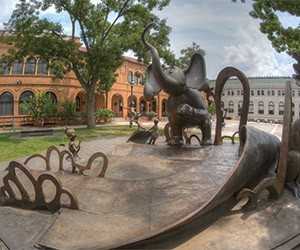Springfield and the Berkshires immerse visitors in history. From literature to sports history and everything in between, groups can virtually step into a time machine and choose from a retro palette of options to revisit decades and even centuries past.
Springfield
No matter what a group’s special interests may be, Springfield’s emphasis on its history provides a full range of options for groups, with attractions spread out all over the landscape.
“We have a lot of historical attractions in our region, everything from living history museums to sports shrines,” explains Mary Kay Wydra, president of the Greater Springfield CVB. “We’re the birthplace of basketball and volleyball. They have definitely helped in terms of offerings for meeting planners, whether it’s pre or post activities, or luring them here.”
Even groups with the most obscure interests will discover something relevant in the Springfield area. Just a few months ago, a national historical group devoted to pipe organs rolled into town and wound up at the Holyoke Merry-Go-Round to see its circa-1930 Artizan Factories pipe organ.
In another case, the elaborate genealogical records housed at the Springfield History Library and Archives and Deerfield Public Library heavily factored into a recent group’s decision to stage their annual event in the area.
When it comes to sports, Alicia Szenda, the Greater Springfield CVB’s director of sales, says that shrines dedicated to the birth of volleyball and basketball are often used as selling points to bring groups to the destination. Springfield is home to the Naismith Memorial Basketball Hall of Fame while Holyoke features the Volleyball Hall of Fame.
“It’s very rarely a group comes to town, and says, ‘Hey we want to go somewhere and do something that’s relevant to what we do,’ that I cannot come up with something for them to do in our area,” Szenda explains. “It’s nice that we can find those niches for folks, and even some meeting space for them to meet in.”
There are many venue options for groups of any size, including the Springfield Armory National Historic Site, which is the first armory George Washington ever commissioned.
By comparison, a smaller group can stage a site-specific gathering in one of the region’s many historic villages or museums to experience what life was like 200 years ago. Storrowton Village, for instance, is just one venue in the Eastern States Exposition complex, and provides a throwback to what New England looked like in the 18th and 19th centuries.
This network of historic towns is increasingly growing popular with groups. Previously, Springfield groups would add an extra afternoon to explore the area at the most, but nowadays, groups are spending more time.
“A couple of years ago, people would come to town, they’d have their meeting, and then they would go,” Wydra says. “Now we’re starting to build more time in for sightseeing, pre, post or even during the event.”
Berkshires
The Berkshires originally came to prominence as a playground for affluent New York City dwellers during the Gilded Age. Both the Boston Symphony Orchestra and the Jacob’s Pillow Dance Festival first arrived 85 years ago. Popular attractions include the Clark Art Museum, the Norman Rockwell Museum and MASS MoCA (Massachusetts Museum of Contemporary Art).
PageBreak
In the Berkshires, land and food are inseparable from the region’s history. People in this part of the country were practicing farm-to-table before that term even existed. The Berkshires were also the birthplace of community supported agriculture.
Many cities comprise the area, each of which offers a different slice of history.
“The Berkshires is 32 towns,” says Lindsey Schmid, director of marketing for the Berkshire Visitors Bureau. “And they’re all about 15 minutes apart. So the experience is very different in each town.”
One common attraction in the region is its wealth of restored homes. Groups interested in the history of literature, for example, will enjoy venues like the Edith Wharton home or Herman Melville’s old house, both of which are now museums. In each case, the venue regularly caters to group business. Wharton’s home is even a destination for filmmakers.
“Her gardens have been brought back to their original intent,” Schmid says. “Her entire library collection is housed there, plus you can tour the house, you can do a Fountain Abbey/downstairs/upstairs tour, a ghost tour, a garden tour, or just come on Friday night and listen to jazz and sip a glass of wine on the back patio and pretend you’re one of those people in the Gilded Age.”
In Melville’s case, he wrote Moby Dick while living at Arrowhead in the Berkshires. Mt. Greylock, the largest peak in Massachusetts, was the inspiration for the novel and groups can even visit his old writing studio and look out the same window toward the mountain. Group hikes are common, as are tours of the surrounding area.
“They’re also in the process of bringing the farmland back to the original intent, in terms of what it would have looked like when he was there,” Schmid says.
Daniel Chester French, who sculpted the Lincoln Memorial, also lived in the Berkshires. Groups can visit Chesterwood, his country home and studio. Tours of the property are common, as visitors can even see the different vignettes he created before the final design was completed. Garden tours for groups are also common.
“All these historical places in the Berkshires also have amazing gardens,” Schmid says. “Because people came from New York City, where they had no space, and this is their chance to come have a lovely home and spend time outside and enjoy the outdoors. Or on the farm, so they can then ship the food back, which they spent all summer growing.”







